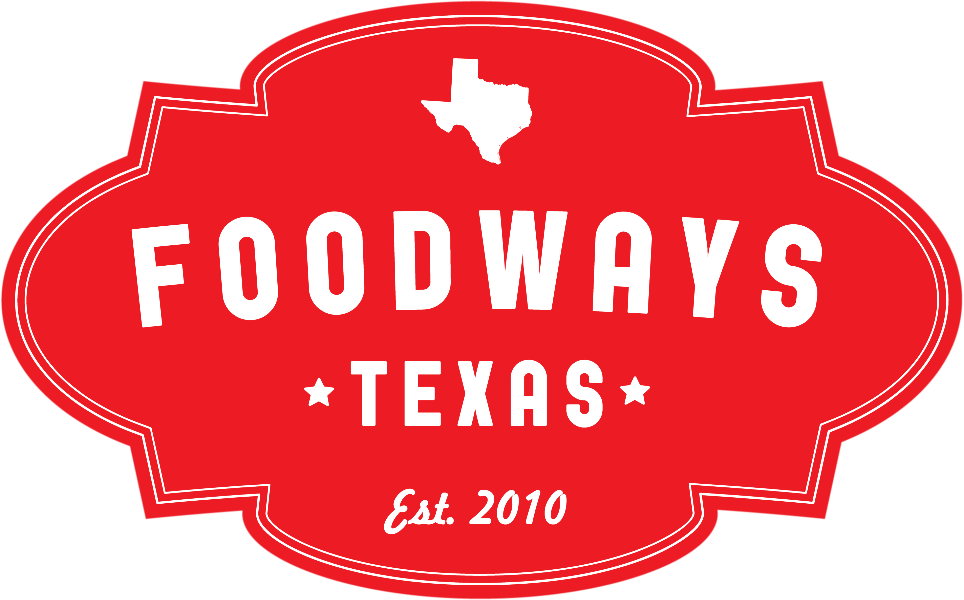Interviewer: Rien Fertel
Location: 3755 Southmore Boulevard, Houston, TX 77004 (Closed)
This interview is a production of Foodways Texas. Photos by Denny Culbert.
Born in Ville Platte, Louisiana, Thelma Williams relocated to Houston in 1969. After working and learning the restaurant and brisket trade at Kessler's Barbecue, she opened her own place in December 1999.
Thelma cooked, her five-year-old granddaughter worked the cash register, and her customers ate in living room-type surroundings. A fire forced Williams to move in 2009; on Southmore she again smoked briskets for 16 to 18 hours over a mix of hickory coals and “a little bit of this, and a little bit of that.” Early in 2013, a rent dispute forced Thelma’s Bar-B-Q out of business.
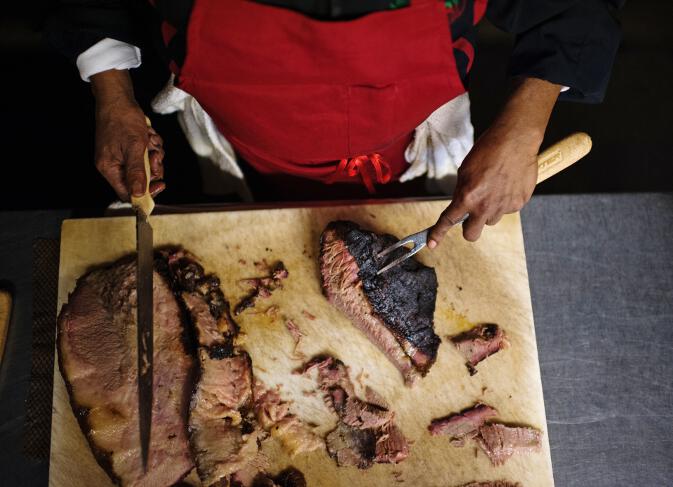
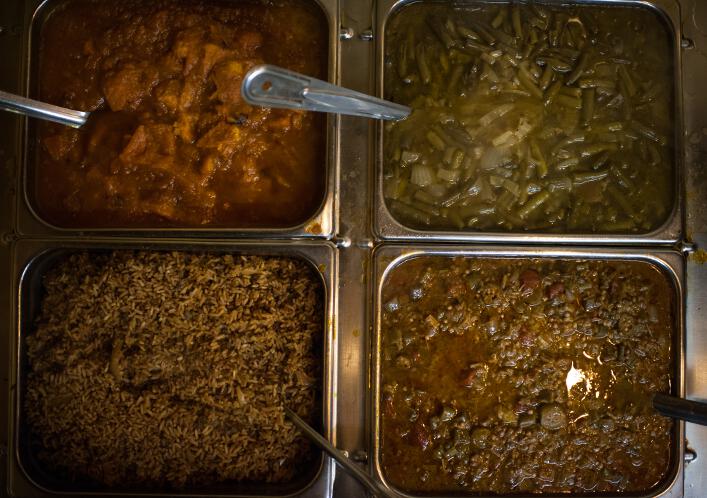


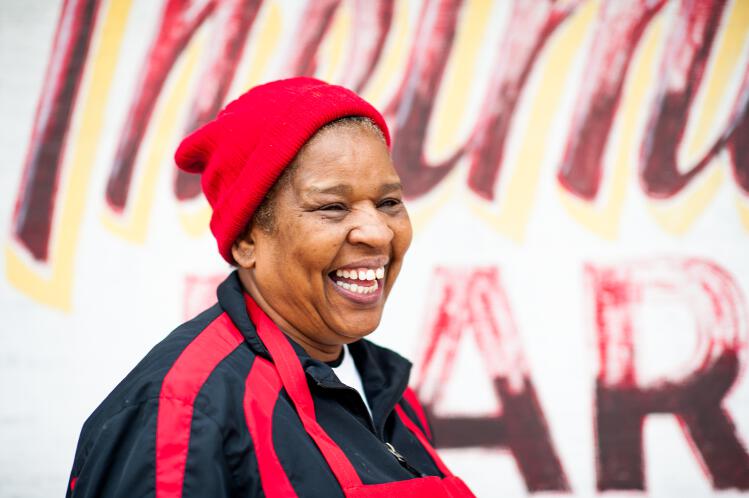
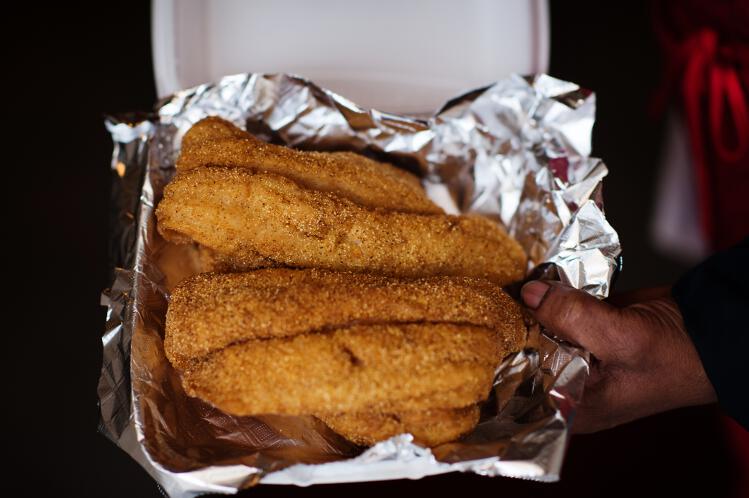
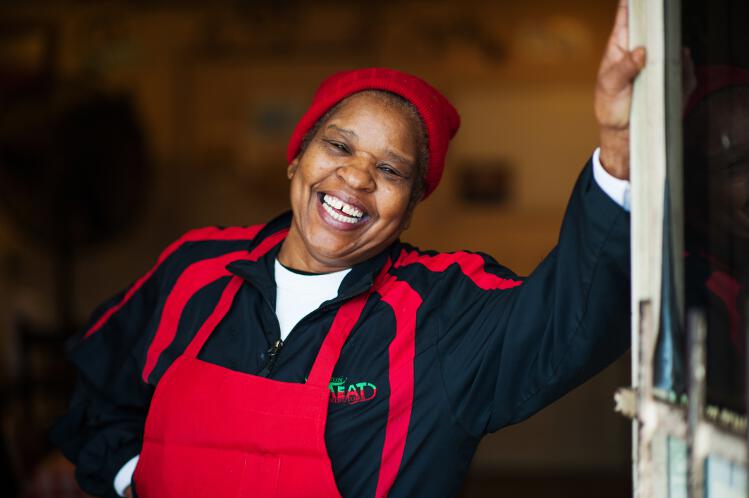
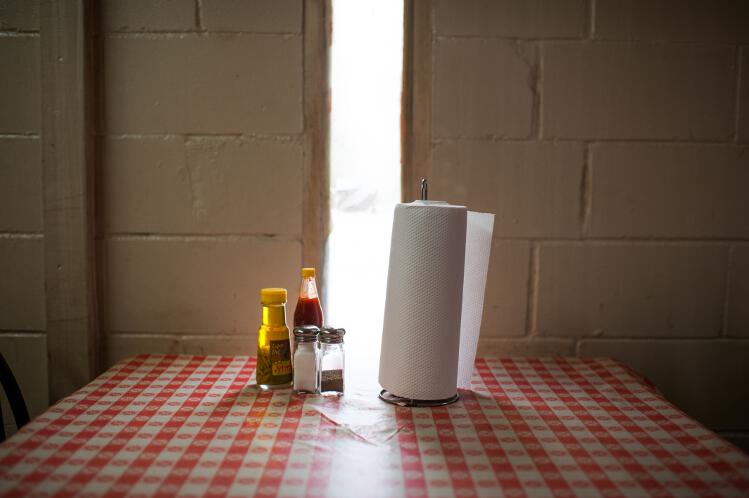
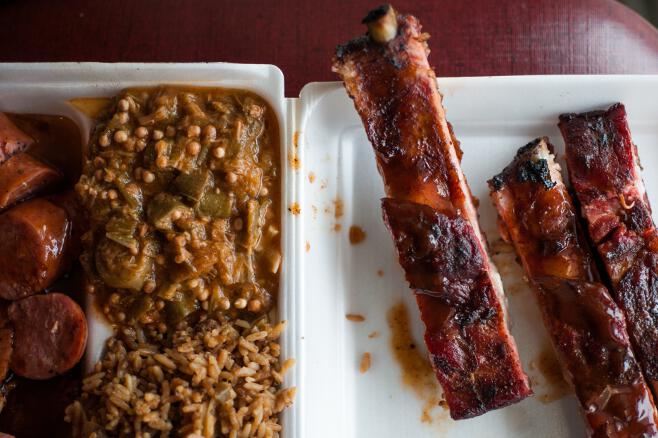
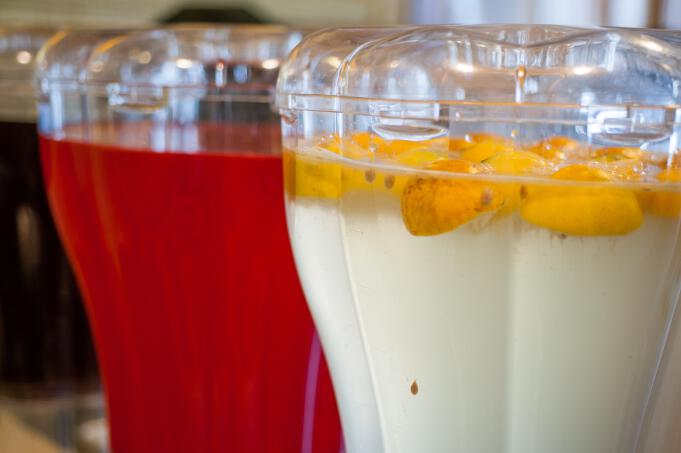
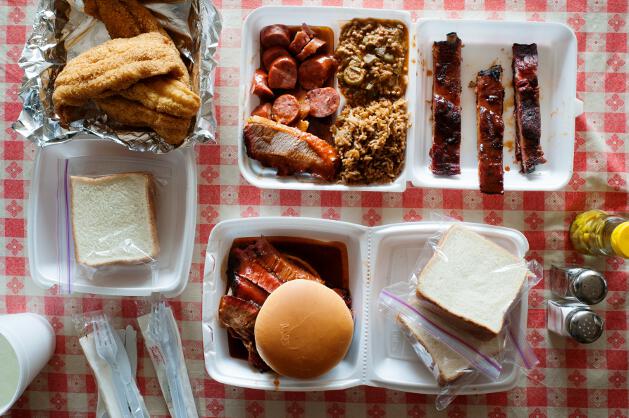
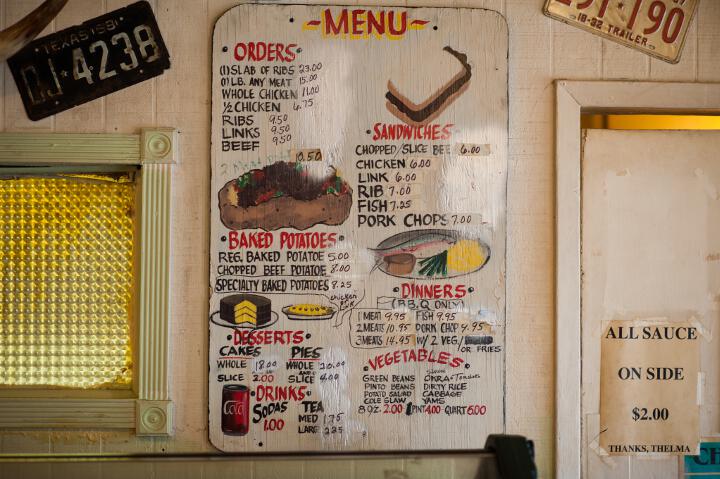
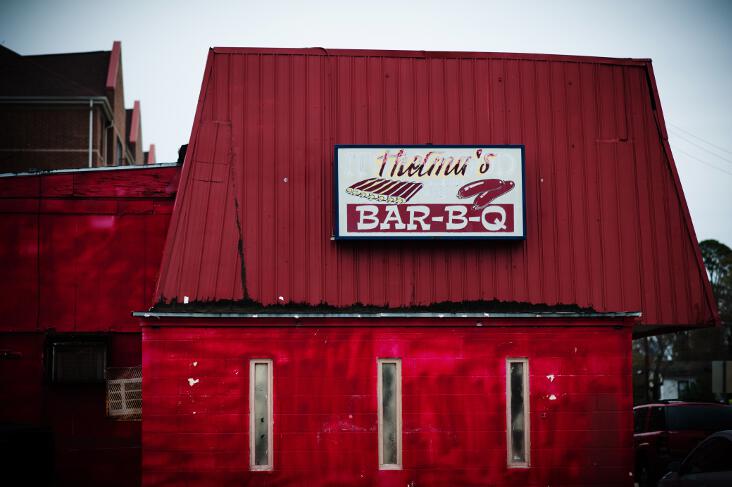
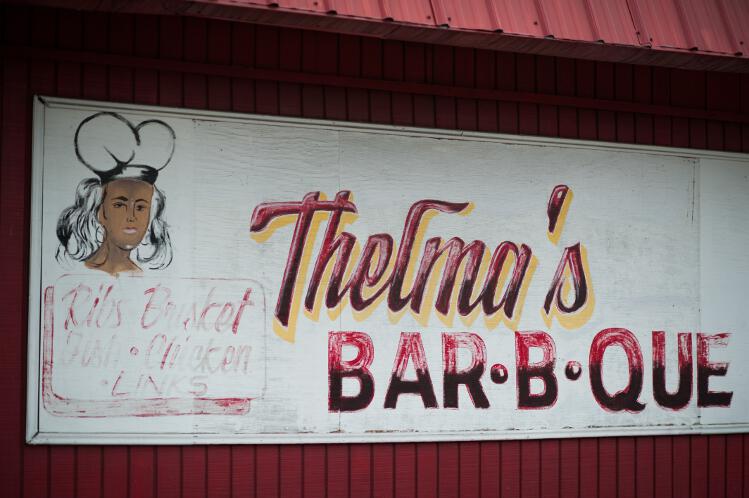
Rien Fertel (RF): Alright, this is Rien Fertel, with Foodways Texas. It is just past eight in the morning, on Friday, January the fourth, 2013. I am sitting in Thelma’s Bar-B-Q, with Ms. Thelma Williams. We are at 3755 Southmore Boulevard, in Houston, Texas. And I’m gonna have Ms. Williams introduce herself, please.
Thelma Williams (TW): Good morning, my name is Thelma Williams. And I am at 3755 Southmore, I’m with Thelma’s barbecue.
RF: And your birth date?
TW: And my birth date is January the sixth, 1950, I was born. So, soon I will have a birthday.
RF: Well, Happy Birthday.
TW: Thank you. Thank you.
RF: Where did you get your start? How old is Thelma’s Bar-B-Q?
TW: Thelma’s Bar-B-Q is thirteen years old. I started on December twenty-first, 1999, there was four days before Christmas, in 1999.
RF: And why did you start the barbecue place?
TW: I’ve always dreamed that—to have my own place of business, and I just stepped out on faith, that’s it.
RF: So, tell me, you’re not originally from here, where are you originally from?
TW: I’m from Ville Platte, Louisiana. A population of 2,000 people. [Laughter]
RF: So, I’m familiar with Ville Platte, but someone who’s listening to this might not be. Tell us a bit about Ville Platte.
TW: Ville Platte is a little small country town, population of 2,000 people, but where the crops are grown, like picking cotton, digging potatoes, breaking corn, and farm—it’s just the farm land, that’s all it is.
RF: And—and tell us about what did your family do in Ville Platte?
TW: My family worked for the Vidrine—Doctor Vidrine. My parents worked the—my father worked the yard, and my mother worked the inside.
RF: And what was it like growing up in Ville Platte?
TW: Oh, it was rough. [Laughter] While we were the siblings of—of twelve, so everybody has to pitch in, and cook, clean up, and do what’s possible.
RF: What, who did? Who did most of the cooking, in your family, in the home? I mean, twelve siblings, lots of mouths to feed.
TW: Everybody. Everybody had to pitch in. [Laughter]
RF: So, who—who taught you how to cook? Was it your mom? Grandmother?
TW: No, my mom, my mom. It just about watching, you know, you learn a lot by watching. And sometimes she’d let you put your hands in it, but not always. But you learn by watching. And the only thing I can’t do—I don’t know how to measure. I only had the hand feel, that’s all.
RF: Was there any barbecue in Ville Platte?
TW: No, not that I know of. And then my—my father, like we worked for the Vidrines, when they had company parties, or they had parties, my daddy would do the barbecuing for them.
RF: Oh, so, your—your father would barbecue.
TW: Yeah.
RF: What would he barbecue, do you remember?
TW: Yeah, it would be like chicken, pork steak, Boston butt, ducks. Name it and he did it all.
RF: What did you eat? Did you eat Cajun food? Creole Food? What were you eating in Ville Platte? What were y’all all cooking at home?
TW: We’d—it’s like Cajun food, you know, we make gumbo, we make fried chicken, mashed potatoes, pinto beans, lima beans. Name it, we ate it all.
RF: What appeals to you about barbecue?
TW: I love cooking, and I love people. I—I love talking, I like feeding people, you know. That’s just in my nature.
RF: And—and is barbecue special? I mean, could you open a restaurant, and cook anything?
TW: Yes, yes I can, most definitely. I—I like to cook oxtail, I cook oxtail at home. I cook shrimp étouffée at home. I cook garfish courtbouillon at home. I do a lot of—of Cajun cooking at home. And during our family events, I do a lot of cooking at home, we don’t have barbecue, we have Cajun food at home.
RF: So, you consider yourself a Houstonian now?
TW: Yes, in some way. But I will never forget the roots that I come from.
RF: Well, tell me about it. Tell me about Houston, and—and how you feel about this city? How have you seen it change, over the past, you know, couple of decades that you’ve been here?
TW: Yes, because we have more opportunity here. And we have more opportunity here, and, you know, it’s just like I said, in the beginning: if you want something in life, you have to go out and get it, because it’s not gonna come to you. You have to apply yourself to it. And that’s what I did. I applied myself to—I just stepped out on faith. With no money. And I opened a business, December, twenty-first, 1999. And it went well. So far, thank God.
RF: Well, tell me about that. So, December 1999, tell me about those first days in business. How was it?
TW: The first day in business—[Laughter] I had my, it’s only myself, I had one employee, and that was my five year old granddaughter. How I taught my granddaughter to do: “Stand on this pickle bucket right here. Hit this key here, hit that key here, look what people giving you. Then the amount of money they give you, punch this button right here, and then if you’ve got a mistake—if you’ve got a mistake, call me. And when you punch that green button, that’s how much money you’ve got to count back to them.” And she did, and she was five. And when she was five years old, the first year—the first year she was twenty-four cents short. Praise God. [Laughter]
RF: The whole year, she was only twenty-four cents short? [Laughter]
TW: Twenty-four cents short. [Laughter]
RF: And does—does she? What—what’s her name?
TW: Her name is Kierra Pierre.
RF: So, let’s start with the pit. Where did you get your pit from? I mean, that had to be the first thing, right? So, tell us about that first pit.
TW: The first pit, it was already built inside, on 1020 Live Oak. But when I came to Southmore, I had to have this pit built.
RF: So, you—you were at an original location that was already a barbecue house?
TW: Right, right. It was already a barbecue house, it mainly was like a—a joint, a club.
RF: What was the name of it?
TW: J & J something. [Laughter]
RF: And it was long closed?
TW: It was long closed. And I had to go in and re-structure it, and clean it up, and when I—when I first started, I said, “No, I didn’t want it.” And some of my friends says, “In order for you to get something, you have to clean it up first.” Because you’re not gonna find nothing that’s all ready—all ready, to just step in, and go to work. And so, we did. We revived the whole thing.
RF: And tell me—yesterday, you told me a bit about that first building. Tell me again. You described it as it was like eating in some one’s home.
TW: Yeah.
RF: Tell me a bit about that.
TW: At 1020 Live Oak, it was—it was built like a house, you know, and everybody called it “The Little Red House.” And then, it was more like a homey type, like when you come in, it seems like company was coming to your house and eating. It was warm, and you could feel the atmosphere, it was—it was just good. People just loved to come there. The—they would surround the place.
RF: So, tell us what are the secrets to cooking a brisket? How—how do you get? How do you get a good one?
TW: It’s only time and temperature. Time and temperature. That’s the important—it’s the important part of all meat. It’s the time and the temperature. That’s it.
RF: So, what temperature do you look for, when you’re cooking?
TW: I look for, like 450, no—not above. Just 450, and if it goes down, that’s fine. Because as long as it’s got coals. Because it’s only cooked by smoke and heat. Not fire. Smoke and heat only.
RF: And—and what kind of? How do you get your smoke? What source do you use?
TW: Wood—wood, firewood.
RF: What?
TW: Hickory, I mix, it’s a little bit of this, and a little bit of that.
RF: Is it? Is it like a mathematical mix? Or, it’s just whatever you have?
TW: No, it’s a mathematical mix. [Laughter]
RF: Well, what? What is it? What is it, besides hickory? Can you tell us?
TW: No, I can’t tell you that. [Laughter]
RF: Oh, so it’s a secret. Okay. [Laughter]
TW: It’s a secret.
RF: Well, where do you get your wood from? Can you tell us that?
TW: Yeah, from a—a the wood man, from Charles Simmons.
RF: Okay. And so, when do you put the—the meat on, the brisket?
TW: At four o’clock—the brisket comes on at four o’clock in the afternoon. Sometimes we’re running behind, if we’re busy. But it comes on at no later than 5:00—no later than 5:00, the brisket has to be on.
RF: And—and you take it off in the morning?
TW: Sometimes I take it off, it’s ready, it all depends the temperature outside. Sometimes it will be ready, and sometimes it doesn’t. Sometimes I have to let it cook a little longer.
RF: So, what does the outside temperature do? If it’s really hot, and gets—? Right now it’s forty degrees outside. And then it could get up to a hundred degrees here. So, what does that do to—?
TW: It—it cools down the temperature, because the firebox is on the outside. The firebox is not on the inside. Anytime you’ve got a firebox on the outside, it’s gonna cause the temperature, the—the wood to—to die down some, and it ain’t gonna throw the right heat in it. So, it does better in the summertime.
RF: And what can you—? And do you season the brisket, before it goes on?
TW: Well, definitely, yes. Most definitely. [Laughter] Season the brisket, and put it on. I don’t boil anything; everything is cooked on the pit. Nothing is boiled here, but the pinto beans, and the potatoes.
RF: Can you, without giving away any secrets, can you tell us how you spice the brisket? Is it salty, is it sweet? Is it spicy?
TW: It’s, no, it’s not salty. And it’s not—the brisket is not salty, not sweet. But my barbecue sauce is sweet. You know, that’s where they get the sweetness from, is from the barbecue sauce. But the, if you slice the brisket, and you have only brisket with no sauce, you can taste that wood flavor. You can taste the flavor, you can taste that texture.
